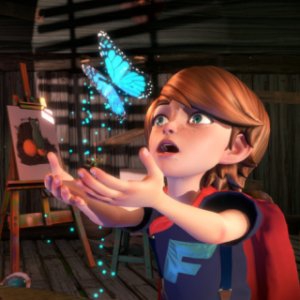
Blending Story and Gameplay in Blackwood Crossing, Available Now on Xbox One
To celebrate Blackwood Crossing’s launch, we’re going to talk through how we approached the balance between story and gameplay in the game. At its heart, Blackwood Crossing is a story. But in telling that story we had to make sure we didn’t end up with a game that wants to be a movie — movies are great, but video games offer unique and powerful ways to tell stories.
Consequently, the problem of how best to marry gameplay to the narrative has always been at the heart of decisions. Our goal: to ensure the gameplay doesn’t break you out of the narrative experience. And, wherever possible, tell the story through gameplay with puzzles and activities that reveal and represent it.

One of our starting points was working out what children’s games would translate well into interactivity, and several of these made it into the final game. The interactivity is not just there for the sake of it. When you play games with Finn, you’re not just completing a task. You’re interacting with him and this helps build a powerful bond.
All the while Finn leads you through a world that we’ve deliberately made reminiscent of an idealized childhood. For instance, there’s a tree house where several of the central scenes take place. If there was a top five list of items that define childhood then, surely, the tree house must be close to the top. Many of us won’t have had one but we can all strongly relate to it, and understand its meaning.

We’re looking to build an emotional link with you, and bring you into Finn’s world. The tree house is where you sit with Finn, early in the game, making elastic powered butterflies. And what’s interesting is that it isn’t a puzzle, but it also isn’t a cut-scene. As you sit making paper butterflies with your brother, it creates a sense of intimacy you don’t get in a movie. The butterflies are also crucial to the unfolding scene, punctuating the dialogue and allowing the characters to use them as a distraction to their real agenda. We’ve framed it in such a way to illustrate key character traits and Finn and Scarlett’s relationship with one another.
We’ve tried to weave these two threads together as close as possible throughout. The activity wouldn’t work without the dialogue, and the dialogue wouldn’t work without the activity.

When we talk about narrative and interactivity, people often ask if the player gets to make meaningful choices that influence the story. Many narrative based games don’t so much tell a story as provide the tools for the player to tell their own – and this can be a very rewarding experience. However, on Blackwood Crossing we have a very specific story we want to tell. Everything that happens in that story has to happen. It’s all part of the journey we’re taking you on, like with a great novel or movie. In crafting that experience, specific things have to happen at specific points, or the emotional journey is diluted. So, while we give the player choice in how they interact with the story and the characters, we can’t hand over the reins entirely. It’s the story that drives the game.
All in all, it’s a tricky line to walk, but our guiding principal has been to create a game that is story driven, but which tells a story that couldn’t be told any other way. The way we tell Blackwood Crossing, it couldn’t be a book or a movie. It has to be a game.
